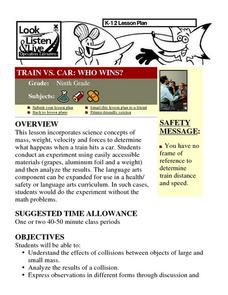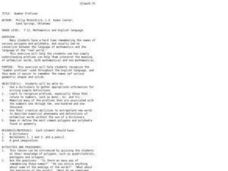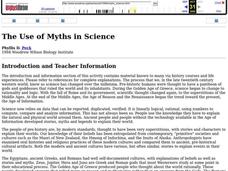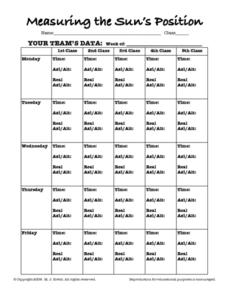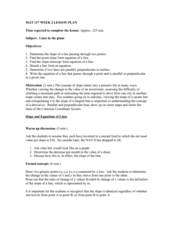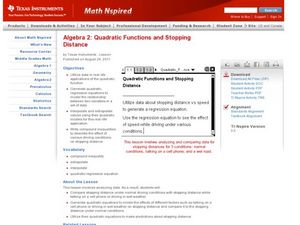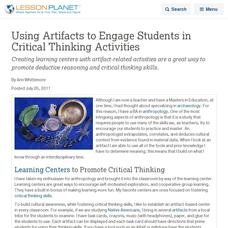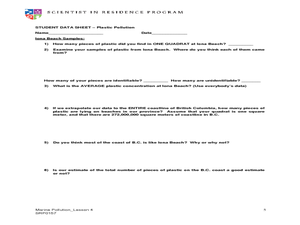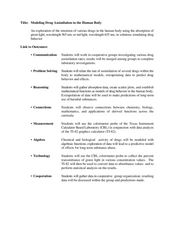Curated OER
Train vs. Car: Who Wins?
Ninth graders conduct an experiment demonstrating what happens when a train hits a car using easily accessible materials. They calculate momentum, velocity, and distance using the appropriate formulas. Then they write an incident report...
Curated OER
Working to Overcome Stereotyping
Students design and conduct a survey to develop an understanding of the challenges inherent in changing attitudes and overcoming stereotypes about the Muslim religion and culture. They create multimedia presentations of the findings.
Curated OER
Number Prefixes
Students recognize the number prefixes used throughout the English language. They identify the shapes and the prefixes that are associated with them.
Curated OER
Storytellers: Pearl Jam "Never Let Truth Get in the Way of a Good Story"
Students analyze the lyrics from a Pearl Jam song and examine the concept of truth in political advertising. They watch the video, "VH1 Storytellers: Pearl Jam," participate in a class discussion, conduct research, and prepare a report...
Curated OER
America's Future Culture
Seventh graders research the past and present policies in the United States regarding immigration. As a class, they read "Immigration Timeline" to examine the various groups who came to America for a better life. To end the lesson,...
Curated OER
The Mozart Effect
Students develop a concept of why skepticism is important in science by looking at actual scientific studies regarding the effect of playing Mozart's music to infants. They record a journal of their inner thoughts and feelings while...
Curated OER
The Use of Myths in Science
Students are told stories, myths and legend to explain their world. After telling the tales and discussion them, students are assigned to write a myth that describes a familiar situation, such as why the school garbage cans are always...
Curated OER
The Use of Myths in Science
Students examine folk tales to determine the basis for scientific myths. They demonstrate through the discussion of the folk tales that the perception of the world has changed as new information is gained. They write their own folk...
Curated OER
Measuring the Sun's Position
In this sun activity, students measure the altitude of the sun and the azimuth of the sun to determine the sun's position five times a day for a week. They answer questions about their results.
Curated OER
It's The States of Matter
Students investigate the properties of solids, liquids and gases. In this states of matter lesson plan, students observe dry ice and its characteristics. They calculate the density of dry ice and observe the sublimation of the dry ice...
Curated OER
Interpreting Women in Islam
Students examine the progressive movement in Muslim nations. In this Muslim culture lesson, students explore the evolution of Muslim women's rights. Students investigate primary Muslim sources that require them to consider compare the...
Curated OER
How Women Got the Vote: The Story of Carrie Lane Chapman Catt
Students participate in a simulation and compare and contrast the arguments for and against womens' right to vote. In this civil rights lesson plan, students simulate disenfranchisement of women by allowing only half of the class to vote...
Curated OER
Andrew Jackson and the Use of Martial Law and the Suspension of Habeas Corpus
Students explore the use of martial law at the Battle of New Orleans. In this Andrew Jackson lesson plan, students analyze primary documents pertaining to the move by Jackson to use martial law in the battle. Students then consider...
Curated OER
Surface Area and Measuring
Tenth graders explore volume and surface area through percentages. In this geometry lesson plan, 10th graders analyze the surface area of two and three dimensional shapes, then use percents and ratio to compare the two.
Curated OER
Lines in the Plane
Young scholars differentiate between parallel and perpendicular lines. In this algebra lesson plan, students graph linear equations using the slope intercept form. They classify lines based on their slopes.
Curated OER
Quadratic Functions and Stopping Distance
Students solve quadratic equations. In this algebra lesson, students factor and graph quadratic functions. they use the properties of quadratics to calculate the distance.
Curated OER
Modeling Natural Disaster with Mathematical Functions
Ninth graders investigate the functional relationship of different environmental phenomena. In this math lesson, 9th graders create models of various natural disasters. They use logarithmic and exponential functions to interpret...
Curated OER
Using Artifacts to Engage Students in Critical Thinking Activities
Creating learning centers with artifact-related activities are a great way to promote deductive reasoning and critical thinking skills.
Curated OER
Playing with Shakespeare's Language
Students can understand Shakespeare's language using comprehensible input and dramatic play.
Curated OER
Rapid Ecological Assessments
Students conduct an ecological assessment of a small area on school property. They inventory plant and animal life of a sample area and make calculations to determine implications for a larger area.
Curated OER
Beginning Modeling for Linear and Quadratic Data
Students create models to represent both linear and quadratic equations. In this algebra lesson, students collect data from the real world and analyze it. They graph and differentiate between the two types.
Curated OER
Dating Sedimentary Strata
Students investigate how the age of sedimentary strata is determined. In this sedimentary strata lesson, students work through problems that show that geological history covers millions of years. They distinguish between relative and...
Curated OER
Plastic Pollution
Students determine with math concepts how much plastic pollution is affecting marine life. In this plastic pollution lesson plan, students collect scientific data from a field trip to a water treatment plant.
Curated OER
Modeling Drug Assimilation in the Human Body
Students investigate the accumulation of drugs in the body. In this algebra instructional activity, students collect data on drug retention and assimilation. They use their data to predict the behavior and effects of drugs.


